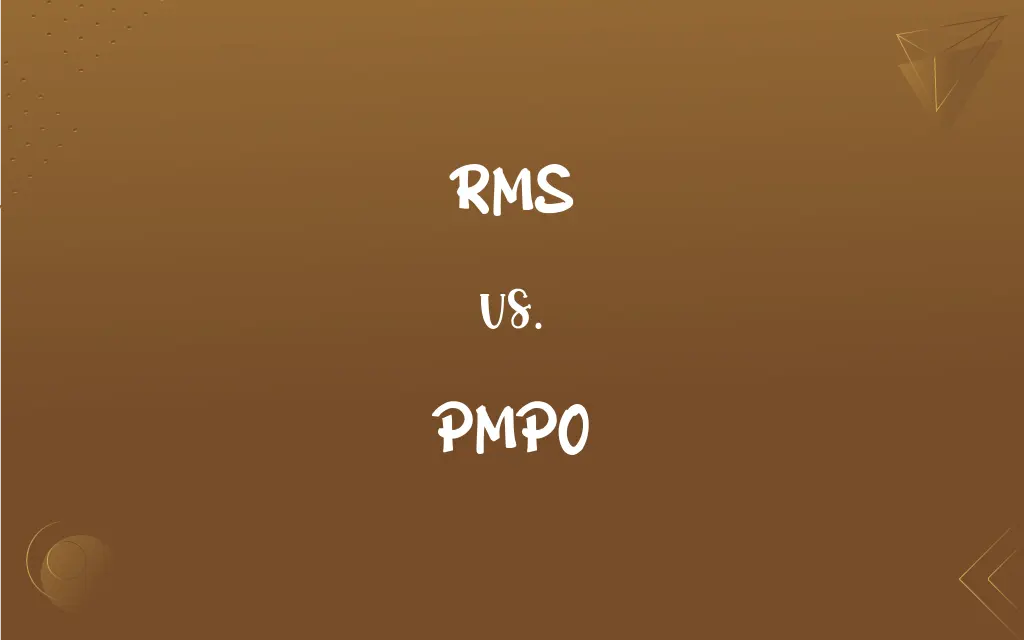RMS vs. PMPO: What's the Difference?
Edited by Aimie Carlson || By Harlon Moss || Published on February 27, 2024
RMS (Root Mean Square) is a measure of the continuous power a speaker can handle, while PMPO (Peak Music Power Output) denotes the maximum power a speaker can handle in short bursts.

Key Differences
RMS, or Root Mean Square, is a more reliable and standardized measure of audio output, reflecting the average power a speaker or amplifier can continuously handle without distortion. PMPO, or Peak Music Power Output, indicates the maximum power level a speaker can handle in short bursts, but this measurement is often seen as less standardized and can be misleading.
The RMS value gives consumers a more realistic understanding of a speaker's performance in typical listening conditions. PMPO, however, often presents higher power numbers, which might seem appealing but don’t necessarily represent typical usage.
When comparing RMS and PMPO, RMS values are usually much lower than PMPO. This is because RMS measures continuous power capacity, while PMPO measures power in peak, often unrealistic, conditions.
RMS is generally considered a more trustworthy indicator of audio equipment's performance, as it aligns more closely with how the equipment will be used in real-world scenarios. PMPO, while offering insight into a speaker's peak capabilities, is less reflective of everyday performance and can vary greatly depending on the manufacturer's testing methods.
Audio professionals and knowledgeable consumers tend to rely on RMS ratings for a more accurate assessment of speaker and amplifier capabilities, while PMPO is often used in marketing materials to highlight the high power potential of audio equipment.
ADVERTISEMENT
Comparison Chart
Definition
Measure of continuous power handling
Maximum power handling in short bursts
Reliability
Generally more reliable and standardized
Less standardized, can be misleading
Typical Value Comparison
Lower than PMPO
Higher than RMS
Usage
Reflects real-world, continuous usage
Reflects short-term, peak capabilities
Preference in Industry
Preferred for accurate assessment of performance
Often used for marketing purposes
ADVERTISEMENT
RMS and PMPO Definitions
RMS
RMS reflects the average power a speaker can handle consistently.
A high RMS rating means the speaker can handle more power.
PMPO
PMPO refers to the peak power output a speaker can achieve.
This speaker system boasts a PMPO of 1000 watts.
RMS
RMS is crucial for understanding the endurance of audio equipment.
Choose a speaker with an RMS suitable for your room size.
PMPO
PMPO is less reliable for assessing true audio performance.
For everyday use, focus on RMS rather than PMPO.
RMS
RMS is a standard for measuring continuous power output in audio equipment.
This amplifier has an RMS of 50 watts.
PMPO
PMPO can give an inflated sense of a speaker's capabilities.
Be cautious, as PMPO values can be misleading.
RMS
RMS provides a more accurate picture of speaker capabilities.
RMS ratings are more reliable than PMPO.
PMPO
PMPO measures the maximum power output in short bursts.
PMPO indicates the speaker's peak performance level.
RMS
RMS is used to gauge the real-world performance of audio devices.
I prefer speakers with a good RMS for quality sound.
PMPO
PMPO is often used in marketing to highlight a speaker's power.
The PMPO rating makes the speaker seem more powerful than it is in regular use.
FAQs
What does PMPO stand for?
Peak Music Power Output, indicating maximum speaker power in short bursts.
How is RMS power calculated?
RMS power is calculated using the root mean square of the electrical signal.
What is RMS in audio equipment?
RMS is the measure of continuous power a speaker or amplifier can handle.
Can PMPO values be trusted?
PMPO can be misleading and often overstates a speaker's capabilities.
What is a good RMS rating for home speakers?
It depends on room size and listening preferences, but typically 20-100 watts RMS is sufficient for home use.
Are RMS values standard across all brands?
Generally, yes, RMS is a standardized measurement in the audio industry.
How can I compare speakers with different PMPO ratings?
Focus on RMS ratings for a more accurate comparison.
Is RMS a better indicator than PMPO for buying speakers?
Yes, RMS provides a more realistic measure of speaker performance.
Why do manufacturers use PMPO?
PMPO is often used for marketing purposes to make products appear more powerful.
What is the average RMS for a quality home theater system?
A quality home theater system typically has an RMS rating between 50 to 150 watts per channel.
How do I know if a manufacturer's PMPO rating is exaggerated?
Compare the PMPO with the RMS rating and be skeptical of PMPO values that are significantly higher than the RMS.
Does a higher PMPO mean better sound quality?
Not necessarily, as PMPO doesn't directly relate to sound quality.
Should I consider PMPO when buying a car stereo?
RMS is a more reliable measure for car stereos as well.
How does room size affect RMS requirements?
Larger rooms may require speakers with a higher RMS rating.
Can RMS ratings determine loudness?
RMS contributes to understanding loudness but also consider speaker sensitivity.
Does PMPO have any practical use?
PMPO can give a rough idea of a speaker's peak power capacity, but it's not practical for everyday use.
Is PMPO relevant for professional audio equipment?
Professionals prefer RMS for its accuracy in measuring performance.
Is a higher RMS always better?
Not always; it should be appropriate for your listening environment and needs.
Can I calculate PMPO from RMS?
There's no standard formula to convert RMS to PMPO, as PMPO measurements are not standardized.
Are there legal standards for advertising RMS and PMPO?
While there are general advertising standards, specifics for RMS and PMPO can vary by region and aren't strictly regulated.
About Author
Written by
Harlon MossHarlon is a seasoned quality moderator and accomplished content writer for Difference Wiki. An alumnus of the prestigious University of California, he earned his degree in Computer Science. Leveraging his academic background, Harlon brings a meticulous and informed perspective to his work, ensuring content accuracy and excellence.
Edited by
Aimie CarlsonAimie Carlson, holding a master's degree in English literature, is a fervent English language enthusiast. She lends her writing talents to Difference Wiki, a prominent website that specializes in comparisons, offering readers insightful analyses that both captivate and inform.































































